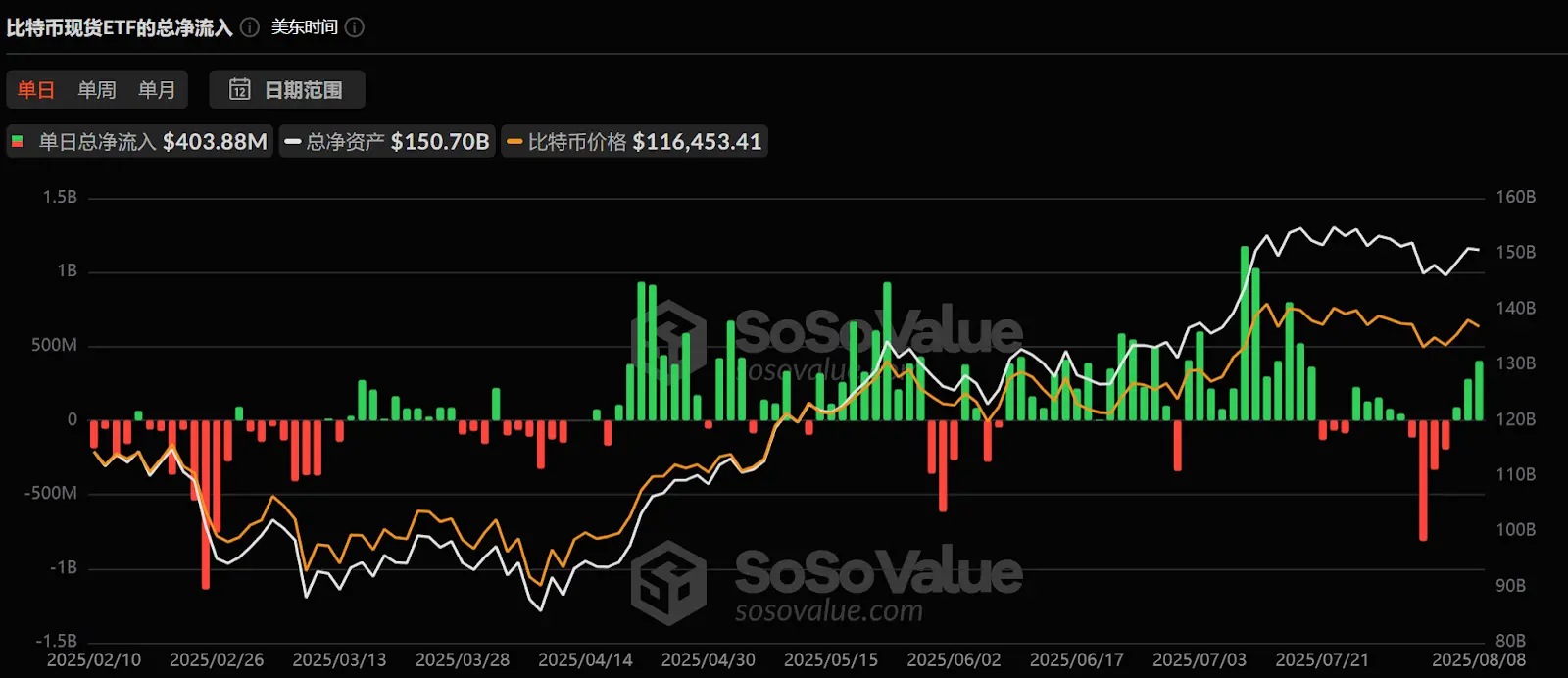Author: Ding Dang, Odaily Planet Daily
The crypto market is surging, and Ethereum is leading this round of acceleration.
In the past 48 hours, ETH has strongly broken through the psychological mark of $4,000, reaching a high of $4,200, and is now trading at $4,194, a new high in 45 months (since December 2021). Since its launch at a low of $1,385 on April 9, ETH has risen by more than 300%, with a monthly increase of 65% in July alone - significantly outperforming most altcoins and becoming the core target of capital siphon.
In contrast, Bitcoin has performed weakly and is still fluctuating in a range of $112,000 to $119,000 and is now trading at $117,200. Solana has rebounded from its low of $155.8 on August 3 to around $180, and its performance in the past two days has also been good. The copycat sector has been fully activated, and the frequent occurrence of favorable projects has promoted market sentiment to heat up, and the signal of the "copycat season" has gradually strengthened.
In terms of liquidation data, the total amount of liquidation in the past 24 hours was US$362 million; Among them, long orders were liquidated by US$78.14 million, short orders were liquidated by US$286 million, and ETH alone contributed US$203 million in liquidation; The largest single liquidation occurred on OKX ETH-USDT-SWAP, with an amount of $10.6284 million.

Capital flows are upward, with Bitcoin spot ETFs turning into net inflows after four consecutive days of net outflows; Ethereum spot ETFs also ended two consecutive days of net outflows, recording net inflows for four consecutive days, indicating that funds are accelerating their return to the crypto market.


Macro catalysis: Trump's executive order and bearish clearance
On August 7, Trump's executive order allowed 401(k) pension plans to officially embrace alternative assets such as cryptocurrencies, private equity, and real estate for the first time. With a fund pool under management of up to $9 trillion, even if only 2% is allocated to crypto assets, it could theoretically bring about an increase of $170 billion - enough to leverage the entire spot ETF market. Although it will take months or even years for the policy to be implemented, its symbolic significance is enough to ignite the imagination of the market. (For details, see "Cryptocurrency officially enters the US pension package, the maximum incremental entrance opens").
On the same day, the Executive Order on Reciprocal Tariffs officially came into effect, imposing tariffs of 15% to 41% on imports from 67 trading partners.
Fed policy shift: expectations of interest rate cuts are heating up
San Francisco Fed President Daly bluntly said that considering the weakening job market and the limited inflationary pressure brought about by tariffs, the interest rate cut window is approaching, and the Fed may cut interest rates by 25 basis points in September or December; If the labor market deteriorates further, there may be more rate cuts.
Trump nominated Milan on Thursday, chairman of the White House Council of Economic Advisers, to serve on the Federal Reserve's board of directors. Analysts generally believe that as the designer of tariff policy, Milan's appointment may make the Fed's policy more dovish and put pressure on Powell to cut interest rates.
Investment banks' analysis tends to be consistent: tariffs have pushed the trade-weighted average rate closer to 20%, a cost shock that erodes corporate profits, erodes household purchasing power, and may force the Fed to act early in the fall. Fidelity International, Berenberg Bank and other institutions have even warned that if policy response is slow, the "lag effect" of 2021-2022 may be repeated.
Capital trends: Institutions accelerate their layout
Michael Saylor, executive chairman of Strategy (formerly MicroStrategy), said that Trump's gold tariffs will "catalyze a new wave of institutional adoption of Bitcoin." This is not just a shout of confidence, but a re-enhancement of the "digital gold" narrative.
Michael Martin, head of Ava Labs incubator Codebase, predicts that venture capital institutions will invest up to $25 billion in crypto startups in 2025, behind the "perfect storm" formed by multiple benefits such as Circle's listing, market recovery, Stripe's acquisition of Privy, Wall Street's increase in blockchain, and regulatory rules.
This year's capital flows have already made people smell the prelude to this storm. Martin noted that $13.2 billion has poured into crypto project financing so far this year, 40% higher than the whole of last year, and is on track to surpass PitchBook's forecast of $18 billion. But he also warned that if the performance of listed companies such as Circle and Coinbase falls short of expectations, or if the macro environment deteriorates due to tariff policies, the pace of capital deployment may slow down.
On-chain data: multiple sectors are rising
On-chain metrics are similarly telling a story of recovery. According to DappRadar data, the total value of DeFi protocol lock-up reached an all-time high of $270 billion in July, an increase of 30% month-on-month. Tokenized stocks emerged as growth highlights, with the number of active wallets surging from around 1,600 to over 90,000, and their market capitalization increasing by 220%.
During the same period, NFT trading volume increased by 96% month-on-month to $530 million, with approximately 3.85 million daily active wallets interacting with NFT DApps, slightly higher than DeFi. Despite the market picking up in July, NFT trading volumes are still lower than their 2021 peaks.
Stablecoins continue to play a cornerstone role in market liquidity. The total circulating supply reached an all-time high of $265 billion, with a growth rate of 5% over the past 30 days. Although there was no double-digit explosion at the beginning of the year, this recovery in the context of continuous low-speed growth means that funds are starting to re-station on the chain, waiting for the next peak.
Recent event tracking of the three major mainstream assets
According to data disclosed by on-chain analyst Ember, in the month since July 10, more than 1.035 million ETH (worth approximately US$4.167 billion) has been hoarded by multiple unknown whales/institutions through exchanges or institutional business platforms, and most of the ETH hoarded by these addresses should belong to institutions or US stock companies that do ETH reserves (excluding SBET addresses), and the average price of these hoarded ETH is about $3,546.
Sharplink Gaming's address has been tracked. A total of 532,914 ETH are currently held, worth $2.07 billion. On August 7, SharpLink announced that it had raised $200 million at $19.5 per share through a rights issue, with the new funds being used to expand the Ethereum treasury. According to its previous rhythm, a new round of large buying orders is already on the way.
Solana's story is a little different. Solana, the digital asset vault company led by Joe McCann, originally planned to raise up to $1.5 billion through a SPAC merger with Gores Holdings X. However, this plan was abruptly halted in recent days for undisclosed reasons. According to previous news, McCann's hedge fund Asymmetric lost nearly 80% of the year, and this stranding made the market speculate: has the capital environment changed, or has the team strategy shifted?
Altcoin Tracking: Four Stories to Watch
Ripple (XRP): Six-year lawsuit comes to an end
The tug-of-war between XRP and the SEC is finally over. The parties jointly dismissed the appeal in the Second Circuit and each bears the costs of litigation. This means that the ruling made by Judge Analisa Torres in 2023 is in effect: secondary market transactions do not constitute securities acts, but large sales to institutions are illegal securities offerings, and Ripple was fined $125 million and permanently banned future violations. Related reading reference "With an increase of more than 70% in July, the market value surpasses PepsiCo and BlackRock, how is XRP's "anti-decline physique" refined? 》
Ripple CEO Brad Garlinghouse said the company will put an end to the legal dispute once and for all and focus on something more important – building an "internet of value." Meanwhile, Ripple's USD stablecoin RLUSD surpassed $600 million in supply in July, up 32% month-on-month, and trading volume reached a record high of $3.3 billion.
Digital Wealth Partners Management, LLC (DWP Management) also announced that it has raised approximately $200 million in its series of private investment funds since April. The company acts as a private fund manager accepting investments in physical digital assets, and all in-kind contributions to date have been made in the form of XRP.
Ethena (ENA): Stabilize confidence with buybacks
On July 21, Ethena Labs announced a $360 million PIPE (private equity) deal with stablecoin issuer StablecoinX, which plans to list on Nasdaq under the ticker symbol "USDE" (the same name as Ethena's stablecoin USDe). Meanwhile, the Ethena Foundation launched a $260 million ENA token buyback program, with an expected investment of approximately $5 million per day over the next 6 weeks to build ENA reserves. Related reading: ENA's "Confidence Game": $260 million buyback stabilizes price, $360 million transfusion StablecoinX sprints to listing".
DeFiLlama data shows that the market capitalization of Ethena's synthetic stablecoin USDe has reached $9.293 billion, an increase of 75.13% over the past month. USDe is currently the third-largest stablecoin by market capitalization, after USDT and USDC.
Chainlink (LINK): Lock your earnings on-chain
Chainlink announced the launch of Chainlink Reserve, a strategic on-chain reserve for LINK tokens, with plans to convert user fees and on-chain service fees for enterprise integration into LINK tokens to underpin the long-term sustainable growth of the Chainlink network, which also signifies a long-term and ongoing buyback program.
Chainlink co-founder Sergey Nazarov said that the market demand for Chainlink has generated hundreds of millions of dollars in revenue for the project, most of which comes from large enterprises. The reserve has accumulated over $1 million worth of LINK tokens at the beginning of its launch and is set to continue to grow in the future.
BounceBit (BB): A new way to play with CeDeFi
BounceBit has partnered with Wall Street asset management giant Franklin Templeton to launch a new product, BB Prime, and launched a token buyback program at the same time. The product integrates Franklin Templeton's tokenized money fund to create a CeDeFi structured product that combines basis arbitrage with Treasury yields. This tokenized fund, which belongs to the BENJI product family, will serve as collateral and settlement tool in investment strategies. In this way, investors can not only obtain the underlying Treasury bond interest rate income, but also superimpose other sources of income. The announced BB token buyback program, backed by over $10 million in protocol revenue, aims to bolster the token's long-term value support.
On the whole, this round of rebound is not only fueled by macro policies, but also by the cooperation of on-chain data, and also fueled by financial sentiment. Whether it is the acceleration of ETH's breakthrough or the recovery of the altcoin sector, the market seems to be accelerating towards a familiar and exciting rhythm.
